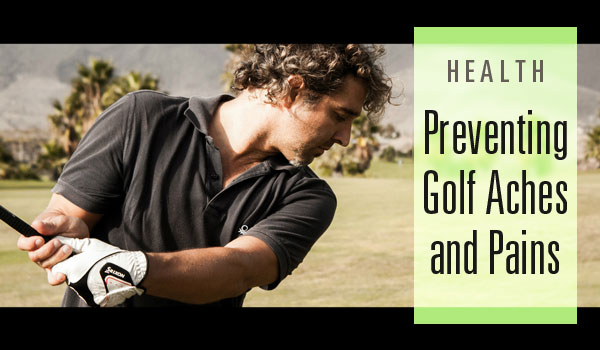Health: Preventing Golf Aches and Pains
 Cary, NC — The average golfer plays approximately 37 rounds per year, so it is no surprise that golf injuries are on the rise.
Cary, NC — The average golfer plays approximately 37 rounds per year, so it is no surprise that golf injuries are on the rise.
Although golf is a low-impact sport, golfers are still vulnerable to repetitive-motion injuries and pain associated with overuse. Lower back pain is the most common injury among both professional and recreational golfers, followed by injury to the elbow, wrist and shoulder.
Avoiding Lower Back Pain
Lower back pain can occur as a result of the combined rotational and extension motions inherent to the golf swing. Studies suggest that increasing the range of arc of spine extension, combined with rotation of the lead hip may decrease the incidence of lower back injury.
Any back pain that radiates to the leg or causes numbness or decreased walking ability may be a sign of nerve involvement. If you experience this kind of pain, see a doctor immediately!
For pain in the lower back, treatment involves rest, anti-inflammatory medications or steroid injections.
Golf Elbow
Elbow injury is the second most common golf-related complaint, with golfer’s elbow and tennis elbow being the most common ailments. Both of these injuries are caused primarily by poor swing technique, and incidence of each increases with age and the frequency of play.
Thoroughly stretching prior to your game, as well as weight training to increase upper body strength, have been shown to lessen the frequency and severity of these elbow injuries. Treatment involves rest, anti-inflammatory medications or steroid injections.
Wrist Injuries Common
Injuries to the wrist are also common among golfers, and are usually caused by overuse of the flexor and extensor tendons. Wrist impaction syndrome is characterized by pain and tenderness at the top of the backswing. Treatment includes rest, splinting or steroid injections.
DeQuervain’s tendonitis is another condition that can cause pain, swelling or tenderness in the wrist near the base of the thumb. In addition, carpal tunnel syndrome is a repetitive stress disorder in which a nerve in the hand is compressed, resulting in numbness and tingling throughout the hand.
Tips To Prevent Golf Injuries
Changing swing technique and strengthening the forearm and hand muscles have been effective in helping to prevent wrist injuries. Golfers should try to avoid excessive cocking or prematurely releasing the hands during the swing. Treatment involves rest, anti-inflammatory medications or steroid injections.
Prevention is the first line of defense against painful, game-ending golf injuries. One study showed that 90 percent of golfers spend less than 10 minutes stretching and warming up prior to play, but those who did were nearly half as likely to experience injury. Improving the mechanics of your swing can also help prevent injury by creating the most efficient, least stressful technique.
When recovering from an injury, return to play slowly, with initial outings limited to chipping and putting. Gradually build up by starting with the shortest clubs and moving to the longer clubs and a full swing. Advancing too quickly to the level of activity prior to your injury can cause further damage and delay your return to the game. If pain continues in spite of preventive measures, surgery may be the only remaining treatment option, but proper equipment, sufficient warm-up, correct grip and swing technique can reduce the need for surgery.
—————————————————————————————
Dr. Mark Galland, a frequent contributor to CaryCitizen on Health and Sports, is a Board Certified Orthopaedic Surgeon specializing in sports medicine. He serves as team physician and orthopaedic consultant to the Carolina Mudcats. Dr. Galland practices at Orthopaedic Specialists of North Carolina. Photo by duesdanfe.
Related: Read more stories about health and sports.


